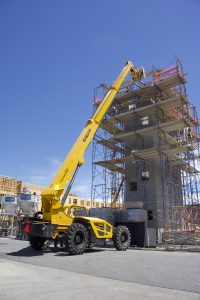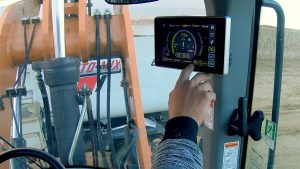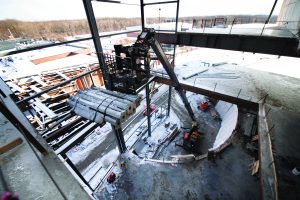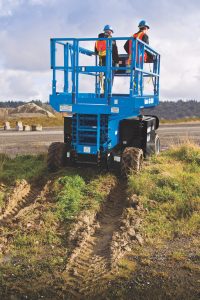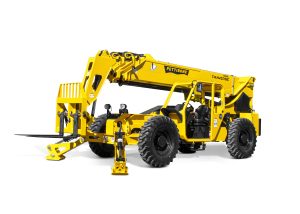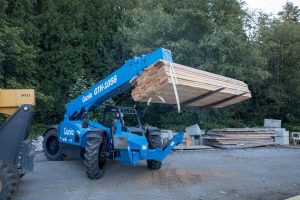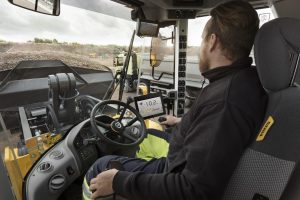
Balance & Reach
By NATE HENDLEY
Construction Equipment TechnologyLifting materials safely and efficiently with mobile equipment.
Mobile lift equipment manufacturers have a slew of solutions, design innovations and tips to make lifting materials safer and more efficient in the face of uneven ground, poor visibility, overloading, wind conditions, and other challenges. For all these improvements, however, OEMs that make wheel loaders, telehandlers, mobile cranes, and scissor lifts, say it’s still important not to ignore the human element.
“Picking and moving objects creates risks on a site and you need to be trained in how to do that safely,” states Amalija Kopac, product manager at Genie. “For telehandler operators, it’s also critical to understand how much your load weighs, where the centre of gravity for your load is, what areas of the load chart your job will operate in, and whether you have the right piece of equipment for the job.”
To this end, many common safety solutions for lifting applications are intended to prevent dangerous situations caused by human error.
Those errors can be as simple as using a bucket too big for the machine and overloading it, which Eric Yeomans, wheel loader product manager at Volvo Construction Equipment, explains can create a risk of the machine tipping over.
Ignoring tire pressure on wheeled vehicles can also be disastrous, he says. “If there’s too low a tire pressure in one wheel, when you lift the bucket, the machine can then also tip over.”
As such, Volvo Construction Equipment provides its wheel loaders with tire pressure monitoring and on-board weighing systems. “You can set what the limit is, and if the operator is exceeding that, you get a warning,” states Yeomans.
Case Construction Equipment enhanced its G Series wheel loaders in 2021 for improved productivity and performance. The company offers a payload monitoring system that’s “integrated directly into the loader’s touchscreen display and provides detail such as bucket weight, pass counts, accumulated/ running weight and job tracking data,” says Andrew Dargatz, the company’s product manager. “This allows operators to precisely load each truck to reduce under/ overload situations.”
These upgraded wheel loaders also feature a new touchscreen and adjustable electro-hydraulic controls with smooth, moderate, and aggressive settings.
These controls make it easier for operators “to adjust the responsiveness of the machine’s boom and bucket functions,” says Dargatz. “Smooth gives you the most control and deliberate movement. Moderate is the factory setting. It provides more of a standard responsiveness. Aggressive provides the most immediate response to joystick operation for operators that like to move aggressively.”
The machine’s aggressive setting also allows for fine bucket metering. “Operators can top off any load more accurately and finely with this capability,” he adds. This spring, JLG released three new rotating telehandlers with a variety of hightech safety solutions: the R1370, R1385 and R11100.
An automatic attachment recognition feature identifies the attachment at the end of the boom then “selects the corresponding load capacity chart and LMIS settings for it,” explains Rogerio dos Santos, the company’s vice-president of engineering for telehandlers.
The LMIS, or load management information system, “visually indicates whether the load is compliant with the load capacity chart and prevents operations that violate the boundaries of that chart,” he continues.
JLG telehandlers also use a Load Stability Indicator (LSI), which works with LMIS to prevent overloads when the load nears maximum capacity.
As the name implies, the upper frame of a rotating telehandler, also called a rotary telehandler, can swivel 360 degrees. This attribute “improves both productivity and safety in congested jobsites,” says dos Santos. “A rotating telehandler can reach several places on the site without the need to drive and maneuver the machine like you have to do with a conventional telehandler.”
The R1370, R1385 and R11100 also have cylinder and chain-driven booms for increased reach and lift capacity. Maximum reach height ranges from 67 to 97 feet, with maximum lift capacity of 11,000 to 13,200 pounds. These telehandlers have automatic leveling systems for uneven ground. When activated, crane supports (outriggers) extend from the telehandler and are manually or automatically positioned to level the frame and secure the machine.
Genie’s rough-terrain scissor lifts have a similar set-up, with self-leveling hydraulic outriggers. “All four outriggers are designed to deploy simultaneously to ensure the lift is level on uneven ground before elevating the platform,” says Genie associate product manager Christian Dube.
These machines are also equipped with “active oscillating axles, which automatically sense the terrain and adjust the rear axle position based on ground conditions. Active oscillating axles combine with four-wheel drive and positive traction control to deliver superior performance on rough terrain,” adds Dube.
Liebherr has a product that complements its existing line of Liebherr Telescopic Mobile (LTM) cranes. LTMs are all-terrain machines with sturdy chassis, and long, strong telescopic booms for operating at height that can handle rough ground. Dense, urban settings present other difficulties, however. Narrow streets and crowded worksites can make it difficult or impossible to evenly extend outriggers on a mobile crane. Reducing base support limits capacity, however.
Enter VarioBase, Liebherr’s variable base support system. Using VarioBase, each outrigger can be individually extended to varying lengths for levelling purposes. Liebherr Computed Control (LICCON), the company’s crane control system, calculates maximum load capacities, continuously updating this data while the crane is in operation. LICCON also monitors the crane’s tipping point and centre of gravity
“VarioBase has really revolutionized the way mobile cranes can function and get into tight workspaces while maintaining the highest level of safety,” states Lee Spalding, sales representative for Liebherr-Canada. “Up to our LTM1300- 6.2, all four outriggers can be placed at any arbitrary length.”
Liebherr has just launched VarioBase Plus, which offers enhanced rear outriggers. An updated control system called LICCON 3, will make its debut on the company’s LTM1110-5.2.
Pettibone also builds a unique telehandler, the Traverse T1056X. The T1056X has a traversing boom carriage that enables it to safely move a load while traveling horizontally. Operators can place a load at full lift height, without having to juggle multiple boom control functions.
“The Traverse enhances operator safety by reducing the number of times that the boom needs to telescope in or out. It also helps avoid the need to reposition the machine by driving it forward and back, which technically is not supposed to be done when operating a forklift,” explains Mitch Fedie, product manager with the company. “Essentially, the Traverse allows you to line up with the target landing and then perform minimal movements to the land the material load.”
The Traverse T1056X has a specified lift height of 56 feet, six inches. The traversing boom provides up to 70 inches of horizontal boom transfer, extending maximum forward reach of the machine to 45 feet, 10 inches. The maximum load capacity is 10,000 pounds.
Other OEMs have also been working on performance-enhancing boom innovations.
Released in early 2021, Genie’s GTH-1056 telehandler features a boom with a mid-pivot point and a single cylinder. “When combined with a wider, stiffer horsehead, this helps transfer loads efficiently in applications that impose high stress on the boom, such as pipe handling or suspended loads, contributing to a stronger boom and chassis design,” says Kopac.
The GTH-1056 also offers improved visibility for operators — a major plus for safety and performance alike.
“Visibility while operating a telehandler is of utmost importance for safe operation,” states Kopac. “We’ve designed our telehandlers for the best possible visibility: the ability to see all four tires as you maneuver the machine. Our GTH-1056, like our other telehandlers, is also equipped with different lighting options and backup rear proximity alarms, as well as telematics that enable remote monitoring.”
“Back-up cameras have become very popular, but it’s still important for the operator to be able to see firsthand when maneuvering,” adds Fedie of Pettibone. “The single lift cylinder [on the Traverse T1056X] certainly helps to provide better sight lines to the rear. Additionally, our side-mounted engine is positioned to allow good curbside visibility while still offering ample ground clearance.”
Liebherr has taken things a step further and offers protection against unseen hazards. The LICCON system contains pre-programmed wind charts, based on the company’s extensive research into the dangers wind poses to cranes.
“With the pre-programmed wind speed charts, all the operator has to do is set the LICCON system to that wind speed and the computer automatically reduces the load charts,” states Spalding. “Liebherr cranes also comply with the CSA Z150, a Canadian safety code on mobile cranes, which adds another layer of safety.”
Even with all their innovations, manufacturers still stress the importance of having operators who are fully versed on the proper use of mobile lift equipment.
“The most important best practice is to ensure that your telehandler and mobile elevated work platform operators have been properly trained by a qualified trainer using the most current training methods,” states Scott Owyen, director of training at Genie.
“Invest in operator training. Everybody invests in equipment, but invest in operator training too,” adds Yeomans.
To this end, Volvo offers operator coaching on its wheel loaders. This program provides unobtrusive feedback and data regarding idling, brake use, tonnage of materials moved, fuel use, and other performance indicators. Volvo also makes Volvo Simulators. These devices consist of a seat, steering wheel, controls and a large screen. Volvo trainers take these simulators to client worksites and put operators through realistic construction site scenarios. It’s a convenient way to train employees without using fuel, or risking injuries or damage to a real vehicle.
Even trained mobile equipment operators need to remain vigilant, however, during lifting applications.
“Always be aware of what you’re lifting—how much it weighs, and how far you’re extending the boom to land the load. Operators should consult the machine’s published load chart to ensure the lifted weight and intended reach are within the telehandler’s capability,” says Fedie, adding, “Be aware of your surroundings at all times when operating the machine.”
Nate Hendley is a freelance writer and author, and is a regular contributor to On-Site Magazine.


